The Durston Gear Kakwa 55 Backpack is an ultralight, internal frame pack that weighs just under 2 pounds with a total volume of 55L plus additional external storage. It has a sewn-on hipbelt, load lifters, an aluminum tubular frame, large hipbelt pockets, and a highly configurable hip belt that provides excellent weight transfer to the hips with moderate loads. The Kakwa 55 is made with Ultra 200 which is a waterproof fabric that is considerably more durable than DCF (Dyneema Composite Fabrics) and is a good choice if you hike in sandy or rocky terrain that is highly abrasive when it comes in contact with backpack bottoms.
Specs at a Glance
- Weight (manufacturer): 28 to 31.1 ounces, depending on size (795g-855 g)
- Weight Actual: 28.8 oz in a size medium
- Materials: Ultra 200D, Heavy-duty polyester mesh (Front Pocket), YKK AquaGuard Zippers
- Gender: Unisex, with S-shaped shoulder straps so comfortable for most women
- Pockets: 8 with 2 side pockets (one with a pocket), 2 hipbelt pockets, 2 shoulder strap pockets, and a front mesh pocket.
- Color: Gray
- Type: Internal Frame (3-sided, aluminum wishbone-shaped tubing )
- Hydration compatible: Yes (hydration port only)
- Seam-taped: No
- Sizing: Multiple fixed length torso ranges from 15″-22″; hipbelt lengths are tied to torso lengths (28″-40″)
- Bear Canister Compatibility: BV500 fits into the extension collar, but only vertically below the top of the frame; BV475 fits horizontally in the upper part of the main compartment below the frame, but only vertically below it; BV450 fits horizontally in the bottom of the main compartment.
- Internal Volume: 43-49L depending on sizing
- External Volume: 15L
- Maximum Recommended Load (SectionHiker): 35-40 lbs
- For full specs, see the product page at Durston Gear
Backpack Storage and Organization
The Kakwa 55 is a classic ultralight pack rolltop pack with a front mesh stretch pocket and side bottle pockets, shoulder strap pockets, and hip belt pocket, allowing you to access the essentials you need during the day without having to stop and open up the main compartment to retrieve them. The pack comes with one tier of side compression cords and a Y-strap to secure gear to the top of the pack and has small webbing loops sewn into the seams if you want to add thin cordage to the exterior to haul bulkier objects.
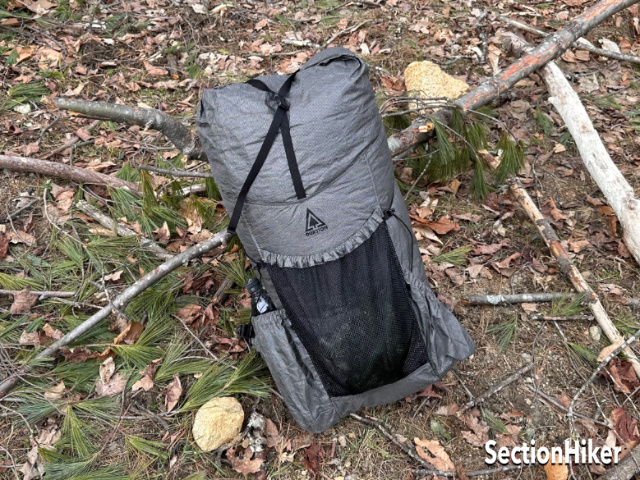
Closed Storage
The main pack bag is a single compartment and holds approximately 55 liters, depending on size (the size small is 51 liters, the size medium is 54 liters, and the size large is 57 liters). This measurement includes the main compartment with two rolls of the extension collar above the frame. Durston Gear claims that there is an additional 15L of storage space in the external open pockets as well. Most mainstream backpack companies (Osprey, Gregory, Deuter, etc.) measure the closed storage differently, only including closed storage up to the top of the frame and not the open storage at all. That said, there is a lot of closed storage space in the Kakwa 55 and plenty for multi-day trips with lightweight gear.
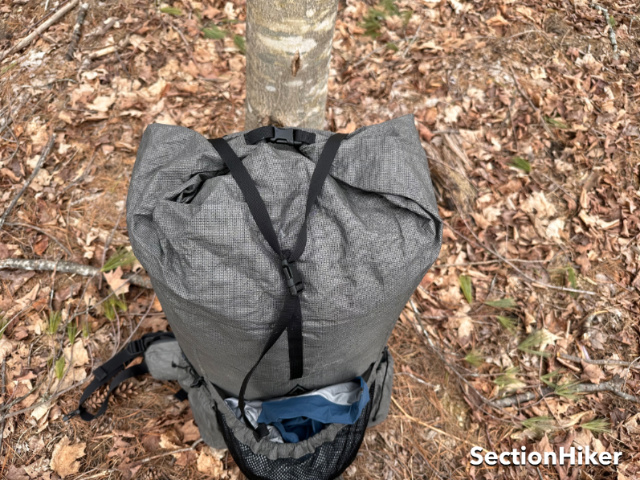
The Kakwa’s main pack bag has quick-release buckles that attach to themselves on top of the pack in the style of a dry bag. There are no additional buckles and webbing on the sides to which you can connect the roll top. I can’t say I’m a fan of roll-top packs built like this because they get hung up easily off-trail when bushwhacking or when winter hiking on trails in deep snow where your pack is in regular contact with the higher branches of trees. I’ve used the Kakwa 55 on several such hikes and its roll-top closure gets consistently snagged in the vegetation overhead: it’s very frustrating. If you don’t hike off-trail or in deep snow, however, it’s unlikely to be a problem. Most backpackers and hikers don’t do either of these things in my experience, although I do both a lot.
Durston Kakwa 55 Backpack
Comfort
Weight
Suspension
Features
Adjustability
Sizing
Durability
Great Suspension System
The Durston Gear Kakwa 55 is a streamlined ultralight-type backpack optimized for thru-hiking and backpacking. It has plenty of external open pockets so you can carry all of your daytime essentials without stopping to open the pack. But where this pack shines is in the frame and suspension system which does an exceptionally fine job of transferring the load to your hips.
The inside of the pack is unadorned, except for a pocket to hold the aluminum frame in place, which is secured closed with a velcro flap. (There is no hydration pocket or place to hang a reservoir although there is a hydration port on the right side of the pack.) In addition to the frame, there’s a thin foam pad, also stored in that pocket to cushion your back. Unfortunately, the pad doesn’t really provide enough cushioning from hard objects and you can feel a bear canister poking you in the back while wearing the pack. The main pack bag also has a tendency to barrel when stuffed tight. You might benefit by putting a few segments of Zlite Sol foam padding up against the frame pocket for more comfort.

Open Storage
The shoulder pockets on the Kakwa 55 are made of a stretchy, Lycra-like mesh with a cordlock and shock cord closure on top. They are a very convenient and accessible way to carry bear spray, phone/camera, satellite messenger, sunglasses, or 16-20 oz water bottles (one-liter bottles are too tall or wide for these pockets). They’re really quite handy.
However, if you prefer to use your own accessory pockets, you can without having to cut the ones that come with the pack off because they are daisy chains running along the outside of the shoulder straps to attach them to. For example, I prefer using the much larger Hyperlite Mountain Gear Shoulder Strap Pocket when I want waterproof storage or the Gossamer Gear Shoulder Strap Pocket and both are easily attached to the Kakwa’s shoulder straps, covering the Lycra pockets that the pack comes with.

The side pockets are asymmetrical, with the right-hand side pocket cut at a diagonal to facilitate easy water bottle access, and the left-hand pocket taller and cut straight across. They fit two Smartwater bottles and even two 32 oz Nalgene bottles, although the fit is considerably tighter with the latter.
Both pockets are cylindrical, with a half-circle of fabric sewn as the bottom of the pocket, level with the bottom of the pack so that they touch the ground when you put the pack down. I’m not sure that’s such a good idea, given the amount of abrasion that will ensue, but Ultra 200 is so much more abrasion-resistant than DCF or Robic Nylon, that it might not matter that much (time will tell.) Perhaps more problematic is that side pockets do not have drain holes, something that Greg Pehrson also noted in his review of the Kakwa 40, where water can leak into the pack seams. We suggest that you use a pack liner whenever you pack up the Kakwa 40 or 55 in a rainy climate. You should do that with any rolltop backpack, anyway.
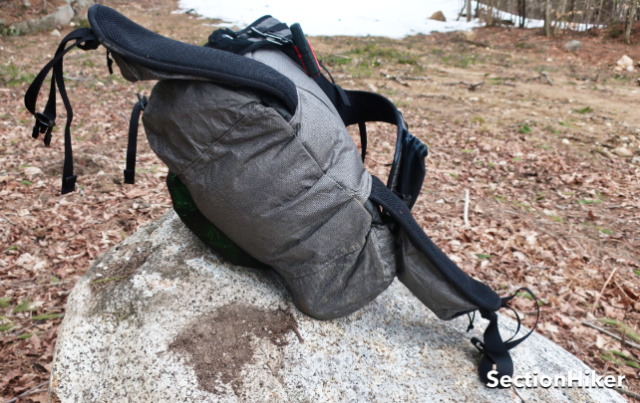
Both side pockets and the front mesh pocket have non-adjustable and non-replaceable elastic that is captured inside a channel of Ultra fabric. The capturing of the elastic means that pocket tension is permanently set; the user can’t tighten or loosen the pockets depending on their contents, which can sometimes be useful when you have to do a long water carry with tall soft bottles.

The taller left-hand pocket is constructed with a double layer of material and has a vertical outer zip creating a small pocket. That outer pocket becomes difficult to use if you overstuff the inner bottle pocket, however, because they share the same volume. It’s not a bad design idea but I found it a little problematic to open and then close while wearing the pack. For example, it would be a good pocket to use to stash something like a wallet that you want to store securely but have easy access to when traveling or in town. But for snacks or extra gloves, my preference is to use the hipbelt pockets or the stretch pockets on the shoulder straps.
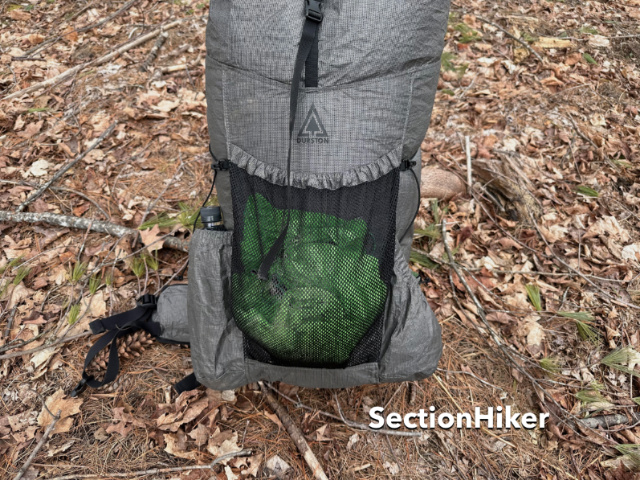
The mesh pocket on the front is a heavy-duty polyester low-stretch mesh that is pleated at the bottom. This means it can expand to hold a Jettboil, a water filter, or wet rain fly/tent but is not droopy when empty. I typically carry layers in a pocket like this instead of stopping to pack them away after a layer change.

The hipbelt pockets are 6” long x 3” tall x 1.5”-2” wide and close with a YKK AquaGuard water-resistant zipper running over the top. The zippers open from front to back and can be easily opened and closed with one hand. I mostly use these pockets to hold snacks, a compass, or a rolled-up map.
Backpack Frame and Suspension
The frame and suspension of the Kakwa 55 pack include the following elements: a wishbone-shaped internal frame tube that’s wide on top but narrows before terminating between the hipbelt wings, a thin internal foam pad, a sewn-on hipbelt with a forward-pull adjustment, S-shaped shoulder straps, and load lifters.

The frame is a hollow aluminum tube bent in an inverted U shape which wish-bones (narrows) when it reaches the small of the back ending on either side of the hipbelt side wings. It’s held in place by two sleeves on each side of the internal frame pocket. There’s really no point in removing it to save weight (4 oz) because it’s the reason why this backpack has such a good load transfer to the hipbelt.

Overall, the hipbelt really works well on this pack. It has a single center buckle, with two independent wings and is tightened by pulling the hipbelt straps forward, called a Sherer Cinch (first introduced by Kelty and designed by Michael Cecot-Sherer, founder of TheTentlab.) The webbing is sewn onto either wing in a sideways V shape to allow for conical tightening (i.e. wider at the bottom, narrower at the top) but each side adjusts with a single pull and there is a just single center buckle to close. This is much simpler and faster to use than packs that requires closing two buckles.
Unlike more modular ultralight packs, the hip belt is sewn to the back of the pack at the point where the frame terminates, providing optimal load transfer to the hips. It doesn’t get any better or more efficient than this. It’s my understanding that Durston Gear tweaked the sizing of the hipbelt slightly between the Kakwa 40 and the newer Kakwa 55 and clarified the sizing parameters so that it’s easier to get a good fit. The only downside of the sewn-on hipbelt design is the length of the hipbelt is tied to torso length which is bound to miss some portion of potential users, like people who are very short and very round.

The shoulder straps are S-shaped, which is better for people with more developed chests/breasts than J-shaped straps because they curve around the chest instead of running directly over it and pressing against it. There is a bar-tacked daisy chain running down the center of each strap, which continues behind the built-in stretch pockets, which are attached at the top and bottom only. The sternum strap hooks to the daisy chains behind the pockets.
The load lifters are attached to a fixed point on the shoulder straps, and to the back panel along the top of the frame. This makes them very effective for repositioning the angle of the pack bag and pulling it closer to your torso and hips. Load lifters are virtually a must-have on framed packs over 50-60L.
External Attachments and Compression
External attachments and compression on the Kakwa 55 are quite simple, consisting of a single tier of static cord and lineloc tensioner on either side of the pack, and a Y-shaped strap of webbing that goes over the top of the pack. There are also a few small loops of grosgrain through which additional attachment points can be rigged up.
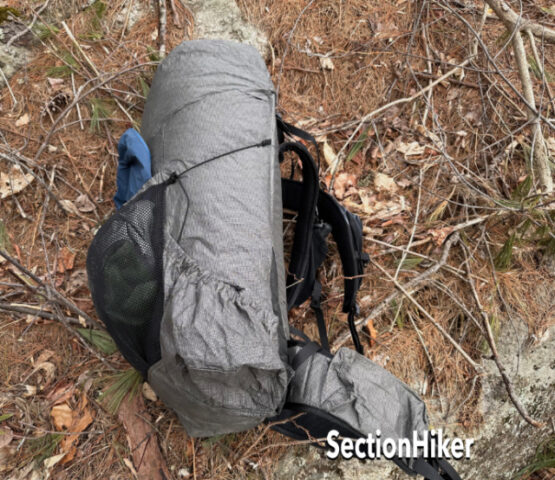
The side compression cord is pretty low utility and is best used to hold long objects against the side of the pack, like a Tenkara rod or trekking poles to keep them from falling out the side pockets. You can also tie things to it like wet socks to dry. Unfortunately, there’s no way to change the angle of the cord so it drops down not up since there are no anchor points on the side opposite the lineloc tensioner to attach the knotted end of the cord. In addition, the problem with a cord like this is that it’s very thin and has a tendency to freeze up in cold weather. It’s also very difficult to strap bulky objects like snowshoes to the sides of the pack, which are best strapped under the top Y strap.
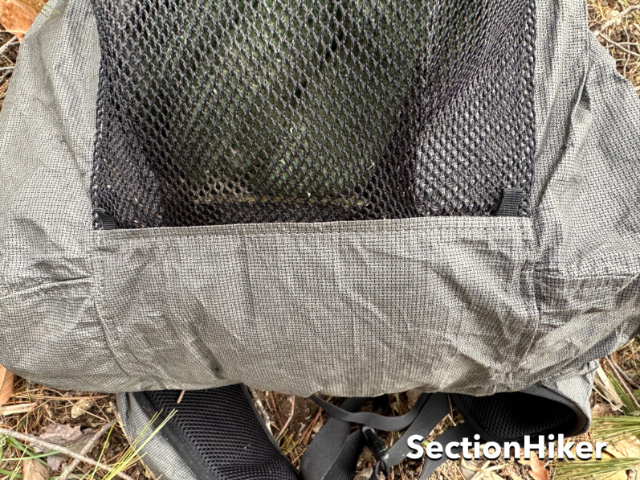
There are two tiny grosgrain loops at the base of the front mesh pocket and along other seams that have enough room to run a very thin cord through. Unfortunately, these loops are so small that a gated buckle won’t fit through them: if you could, you could easily rig up webbing straps all across the exterior of the pack. If I had a vote, that would be an enhancement that would make a big difference in the pack’s utility.

In fact, the only effective way to attach bulky gear like snowshoes, a foam sleeping pad, or a bear canister to the Kakwa 55 is to strap it to the top of the pack using the Y-strap.

Water Resistance
The Kakwa 55 is made with Ultra 200 which is a highly durable waterproof fabric. However, because of the complexity of the seams around the frame assembly, the Kakwa is not seam taped or seam sealed. This means it’s important to use a waterproof liner–a practice that’s a good idea with most any backpack that’s not a legit drybag–in the rain or when packrafting, to keep your gear dry.
Comparable Ultra Backpacks
| Make / Model | Total Volume | Fabric | Weight |
|---|---|---|---|
| Durston Gear Kakwa 40 | 55L | Ultra 200 | 27.8 / 770g |
| Zpacks Arc Haul 50 | 50L | Ultra 200 & 100 | 20.4 oz / 577g |
| ULA UL24 Ohm | 63L | Ultra 200 & 400 | 31.8 oz / 902g |
| LiteAF Ultra Curve 46 | 61L | Ultra 200 | 31 oz / 879g |
| Bonfus Framus 48 | 48L | Ultra 200 | 25.4 oz / 720g |
| Mountain Laurel Designs Exodus | 55L | Ultra 200 & 400 | 18 oz / 510g |
| Volpi Outdoor Gear UL 40 | 45L | Ultra 200 & 100 | 14.8 oz / 420g |
| Superior Wilderness Designs Movement 50 | 50L | Ultra 200 | 23.8 oz / 675 |
Recommendation
The Durston Gear Kakwa 55 is a streamlined ultralight-type backpack optimized for thru-hiking and backpacking in three-season weather when you don’t have to strap much bulky or specialized gear on the exterior of the pack. While it doesn’t really have much in the way of compression or external attachment points, the Kakwa has plenty of external open pockets so you can carry all of your daytime essentials without stopping to open the pack. Where this pack shines is in the frame and suspension system which does an exceptionally fine job of transferring the load to your hips. We’ve examined some limitations with the pack above, but on the whole, it is quite a simple and elegant pack to use if you’re looking for a durable lightweight pack made with Ultra 200 fabric.
Disclosure: Durston Gear donated a backpack for this review.
SectionHiker is reader-supported. We only make money if you purchase a product through our affiliate links. Help us continue to test and write unsponsored and independent gear reviews, beginner FAQs, and free hiking guides. SectionHiker.com Backpacking Gear Reviews and FAQs
SectionHiker.com Backpacking Gear Reviews and FAQs 
Good review! I have been looking at this one, and watching the Durston Gearheads FB page. Like new car models, I wait a season before jumping on a new pack to see what issues pop up in real use. This year’s PCT will be a good test! Your information about how companies measure interior space was eye-opening, as was the roll-top cinching and snagging problem on overgrown trails. Very helpful.
I recently received the Kakwa 55, and so far so good. I too would prefer slightly larger grosgrain loops, but you have to feel for the pack designers. A certain group is going to grouse about too many add ons, and want packs to be MORE ultralight. Another group wants more builtin convenience. I like a pack that is fairly simple, but allows the ability to modify to your personal needs. One could simply run a cord or bungee loop through the small lash points to create their own larger loops.
Regarding the snag problem with the roll-top: I always clip the buckles together on the bottom side of the”roll”. The buckles are covered by the fabric, and you have a flat surface with no loop to be snagged. It might be difficult to accomplish if you have the pack filled to capacity and have the collar fully extended, but I’ve never run into that with any roll-tops.
It’s a very nice backpack.
Thanks for putting this together and sharing your thoughts. That’s interesting that Michael Cecot-Sherer invented this style of hipbelt. I’m familiar with his work in the tent world, and didn’t realize he’d done packs to.
I also appreciate the thoughts on the attachment points. I added more for 2023 but yeah they would be more useful if we made them larger. It would be possible to add cord to these and then clip to the cord but I’ll look at making the attachment loops larger for our next run.
Cheers,
Dan
Dan – if you click on that TentLab link, you’ll see a full page of the products that Scherer has designed. It’s pretty mind-blowing. I learned about him when I reviewed a Spectra Kelty Cloud many years ago.
Bigger grosgrain attachment points and more of them especially along the side seam would make a big difference, especially for us folks who have to deal with 5 months of snow each year. Those gatekeeper buckles, while they’re not that glove-friendly, are removable, so they could be sold as add-ons or ship with the base product and be removed by users to save weight.
Dan, Philip also mentioned that the side pockets do not have drain holes. Is that something you are considering adding?
Thank you for this thorough review! Like the other reviewer, I had never considered how different pack makers might be calculating the volume. I will be checking this now!
I just got mine. Excited to try it out.
I do like using a hydration bladder, and my only complaint is that the opening for the tube is super tiny and doesn’t fit anything through it. Why put an opening for a tube to come through if it’s so small that it’s useless?
The backpack looks nice. Is it available in 4 season as well?
Nope – and it really is pretty challenging to use if you need to carry any extra flotation/traction aids. The external attachment system is pretty lacking.
I like most of the features on this pack EXCEPT that the Ultra 200 fabric rests directly against your back.
That is why I’m getting a new Osprey EXOS 58 with its cool and comfortable mesh trampoline back.
I love my current EXOS but the new one is enough lighter that, in my geezerhood, I’ll opt for “adding lightness”.
I just received my Kakwa 54 and completed a 4 day/50km hike through some very rugged off track country.
My personal preference would be to increase the internal volume by 5 or 10 litres and reduce the amount of external pocket space. I know many others will disagree, but I simply prefer to have all my gear inside.
This would also the. Allow sufficient space to put an internal
Sleeve to hold a water bladder.
One last comment would be to include trekking pole loops. After all this ultralight pack is likely to be coupled with an ultra light tent where trekking poles are usually carried
Can you compare Zpac Arc haul ultra vs Osprey vs Durston Gear Kakwa? What is the maximum comfortable load for these backpacks?
Load capacity, comfort, build quality, …
There are reviews for all of these packs on this website. Why don’t you read through them and then ask me some more specific questions.
For 3-season backpacking, would you prefer the Kakwa 55 or the Seek Outside Flight Two and why? Thanks!
I would choose the Flight because you can strap stuff to the outside. But that’s just me. I have no idea what’s important to you.
“Most mainstream backpack companies (Osprey, Gregory, Deuter, etc.) measure the closed storage differently, only including closed storage up to the top of the frame and not the open storage at all. ”
For clarification, are you saying that Durston packs are larger or smaller than a similarly labeled pack from another company? Sounds like you’re saying they are smaller, but I’m not sure.
If you were to guess, about how big would another company say this pack is?
about a 40L
Dan replied to a recent question of mine with a link to a YouTube video where the volume was measured by filling with water (though no statement of the size (S/M/L)). Dan said the internal volume is closer to 46-50L.
It’s important to me as my starting internal volume and weight for a week in cold/autumn, off-trail alpine conditions is ~55L, 30lbs, sometimes 32 lb with an extra liter of water. I’ve been looking for a 2-2.5 lb pack that can handle that comfortably. The Kakwa, SWD Rugged Long Haul 50 are options. Couldn’t fit the Circuit right. One of the problems of buy-before-you-try model. Philip’s reviews are exceptionally helpful.
Looks like your feedback is used to update 2024 Kakwa 55:
https://www.instagram.com/p/Cv94MV8LotL/
I see larger loops.
Dan is very responsive to my feedback because I’m serious about this kind of thing.
End result = better consumer product!
Thank you both!
What’s New for 2024?
The most notable change for 2024 is that we substantially increased the size of the front mesh pocket. We made the pocket wider, increased the volume with larger pleats, and made the pocket taller by moving our logo onto the pocket at the bottom. This new pocket holds twice the volume of the original pocket while still using knit mesh that is much more durable than lycra based stretch mesh. The new logo panel at the bottom is both functional (as it protects the mesh where it more likely to be damaged) and aesthetic (the angled top edge mirrors the angled seam above the front pocket), while mesh drains at the corners let water out.
Secondly, we have updated the fabrics to use the new “X” variation of Ultra 200 that has the same very durable UHMWPE based weave for the face fabric, but now with a more durable interior lining. This Ultra 200X fabric uses a double thick interior film and new adhesives to extend the life of the waterproofing, while also adding diagonal reinforcement (“X Ply”) on the inside of the material to further strengthen it.
We also made a wide range of smaller updates including adding drain holes to the side pockets, changing the cord tensioners to smoother operating LineLoc3’s, adding two more attachment points (now 12), and enlarging all of the attachment points to tougher webbing for easier operation. While overkill, we also added even more double stitching to the pack including top stitching on a few additional seams to make the robust pack possible.
Art – do you work for Durston or is this a quote?
Will Durston replace all the inferior Kakwa’s that were already sold? Just asking, since I bet a lot of first generation owners are probably pissed off about now since the used price of their packs just dropped.
Not associated, just a follower of hiking gear in general (hence your site reader).
This is directly from an email that was sent to all interested parties (subscribed on the site). Also posted on social media/Duraston site, etc
Not sure about ‘inferior’, just know that Dan and kaviso are very good at customer service.
Dan is known to be iterative updater, constantly listening to feedback and making small improvements to his products over time (see Xmid, kakwa, etc)
I can’t imagine he will – It’s a new version of a product. This would be like asking Apple to replace my iPhone 11 b/c the 12 got announced with improvements.
The 2023 model of the pack was still a fantastic pack by your own admission and unless something went wrong with it in an unexpected way it’s totally reasonable for a cottage company like Durston to iterate on its products year over year.
Similarly to Apple – as already mentioned – the changes each year might/shouldn’t be enough to compel an upgrade, but over the course of years those smaller changes add up to a significantly improved product when the 2022 customer is looking for a new pack in 2027.
Thank you so much for your thoughtful review BTW. Compelled me to get one in light of the 2024 improvements. Hope to see an updated review with the upgrades! Keep it up!
I’m just playing devil’s advocate. But this is one reason why I don’t buy 1.0 products if I can avoid it.
Agree with Philip – “why I don’t buy 1.0 products if I can avoid it.” Especially when it’s from buy-before-you-try companies/no return companies.
Dan is great about improving designs as are most. Based on Philip’s review and other commentary I’m considering the Kakwa 55 and the SWD Rugged Long Haul for 2-2.5lb packs. Know Philip likes the Zpacks Arc Haul but too many comments about fit and durability from others.
Need to haul 32-35 lb occasionally, but usually max out at 30 lb. Seems the Kakwa suspension system could handle that. However, lack of external webbing and lower internal volume vs the Long Haul are points against it. Hope Dan keeps improving it.